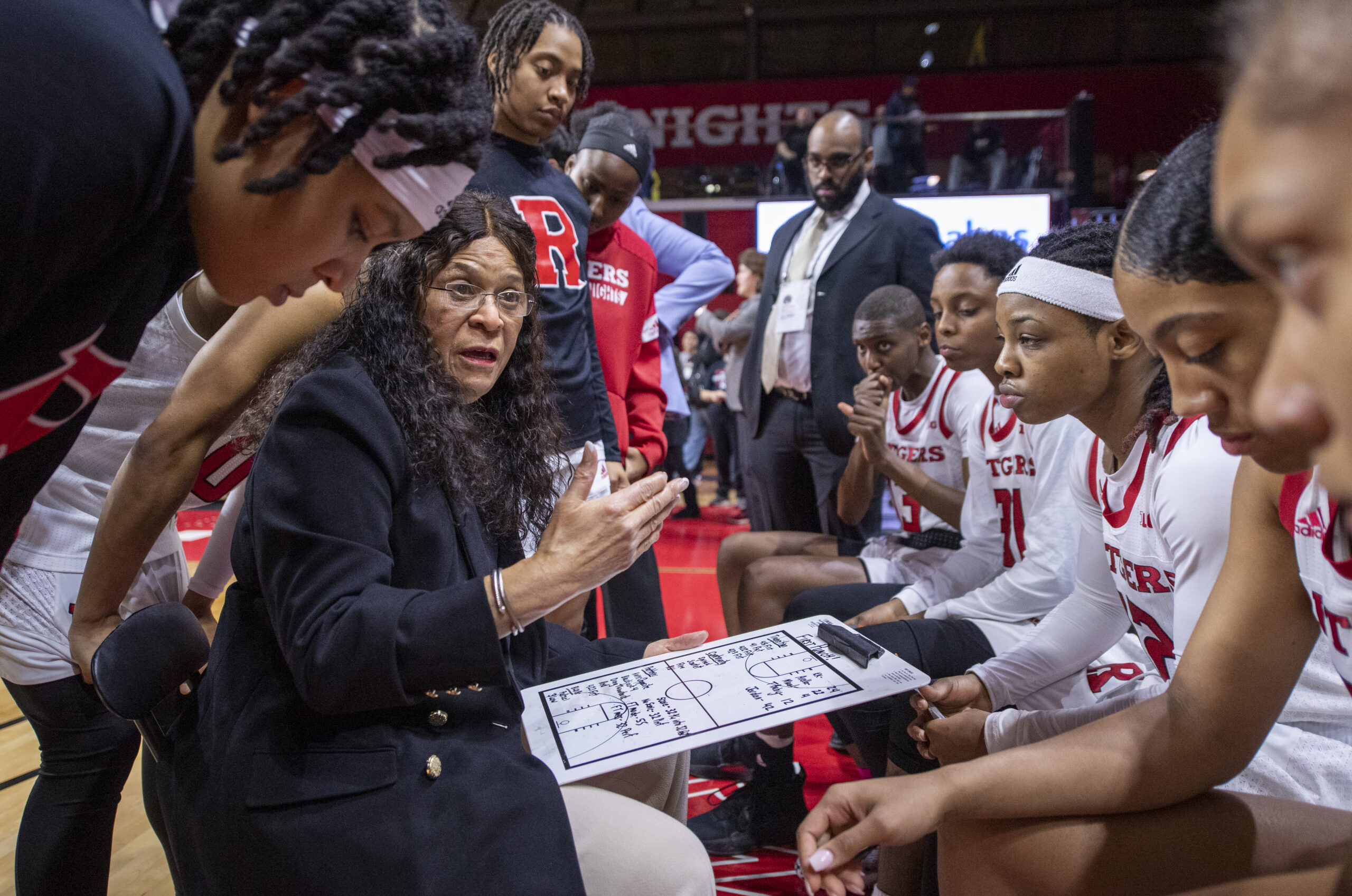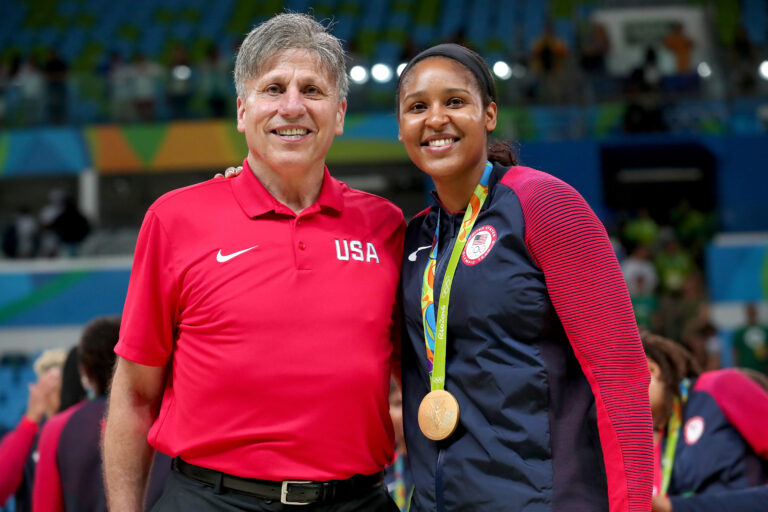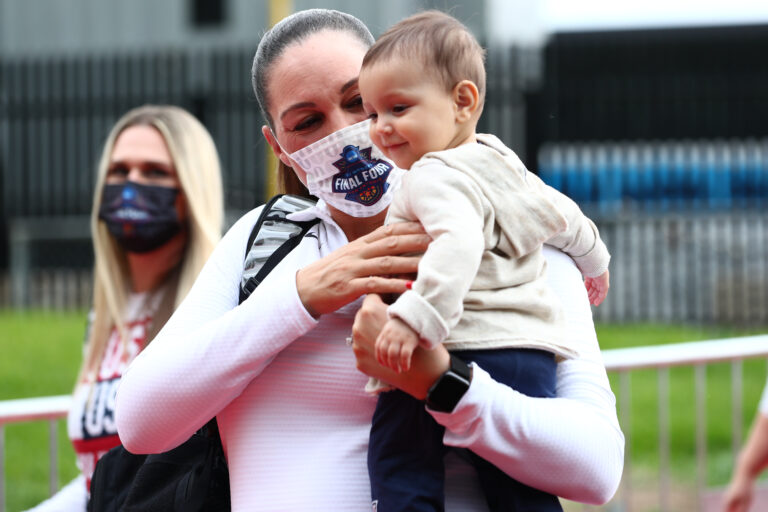How Black Women Coaches Are Pushing Forward Together In Women’s College Hoops
Why this matters
A Global Sport Institute study of women’s basketball coaching changes in the Power 5 shows that Black women coaches continue to not receive job opportunities at the same rate as White men and women. Many of those coaches are working together to overcome racial and gender stereotypes and create chances for themselves and others.
When women’s basketball coaches in the Power 5 conferences began to recruit Jolette Law to join their programs in the 1980s, most of them were White men and women. Law eventually committed to the University of Iowa, where she got to play for the legendary C. Vivian Stringer, a coach she felt she could relate to. And that choice influenced life beyond her career on the court.
After four years at Iowa, followed by a few years as a pro with the Harlem Globetrotters and a season assisting at Ball State University, Law joined Stringer’s coaching staff at Rutgers University, where she stayed for 12 years as an assistant. Today, Law works on the University of South Carolina’s women’s basketball staff, and now has 27 years of coaching experience. None of it would have happened without Stringer’s encouragement.
“She said ‘Jolette, you’re gonna be a coach.’ And I said, ‘no coach, I could never do what you do,’” Law said. “She said, ‘but the knowledge that you have, you’re very brilliant. And I just know one day you’re gonna be a coach.’”
After serving on Stringer’s Rutgers staff, Law took her first head coaching job at Illinois in 2007. She was a part of a wave of Black women coaches in the sport, a period in the mid-2000s in which longtime assistants such as Nikki Fargas, Niya Butts and Coquese Washington received head coaching opportunities at major schools. Largely as a result of that wave and the efforts of established coaches to advocate for their players and assistants, Black women head coaches in general -- and former players in particular -- are more visible than ever in the sport.
In 2020, there were nine head-coaching changes, according to Global Sport Institute Field Study data. Many of these changes were very high-profile. Niele Ivey (the University of Notre Dame) and Kara Lawson (Duke University) took over at Blue Blood women’s basketball schools, while Kyra Elzy (the University of Kentucky) and Nikki McCray (Mississippi State University) added to the already diverse Southeastern Conference (The league now has five Black women head coaches, following McCray’s subsequent departure for health reasons.) From 2016 to 2020, programs hired 16 Black women for head coaching roles in the Power 5 conferences, accounting for 18 percent of the total hires made.
Still, as coaches take on a higher profile and form networks across the sport, Black women in particular face racial and gender stereotypes that make it harder to get into coaching and advance their careers. Optimism persists, and coaches are focusing on what they can control. But the change of the landscape has not gone unnoticed.
University of Notre Dame associate head coach Coquese Washington said that as issues such as abuse in women’s sports, less stringent player transfer rules, and racism in the United States have become more openly discussed, athletic directors at bigger programs have begun to think differently about hires.
“You're definitely hiring people that are qualified from an X's and O's standpoint who are ready for the opportunity,” Washington said. “And they also bring in, in many cases, maybe they bring a different sensibility to the coaching aspect that maybe these athletic directors weren't paying as much attention to.”
Related: More Athletes, Fewer Leaders: The 'Paradox' Facing Women in College Sports
Despite this shift, the number of Black women head coaches does not reflect the demographic makeup of the athletes who compete in the sport, especially in the Power 5. In Division I Historically Black Colleges and Universities (HBCUs) during the 2019-20 season, 92 percent of players identified as Black and 50 percent of head coaches and assistant coaches were Black women. At Predominantly White Institutions (PWIs), by contrast, 42 percent of women’s basketball student athletes identified as Black -- but only 14 percent of head coaches did, while 30 percent of all assistants were Black women. And there’s still one major conference, the Big 12, without a Black woman head coach.
Now as in the past, Black women aren’t getting head coaching opportunities at the same rate as White men and women -- which means they often have to work together to create chances for themselves and other minority coaches.
Building a Pipeline
The modern of era women’s college basketball dates back to the 1972 enactment of Title IX, the federal civil rights law that prohibits sex-based discrimination in schools or education programs receiving federal funding.
Bessie Stockard, a trailblazing Black coach and educator, started the Federal City College women’s basketball program in 1969 and led the team to a No. 1 national ranking in 1974-75. Stringer, the first coach to take three programs to the NCAA Final Four, began her career at Cheyney State in 1972. In 1976, the University of Wisconsin hired Edwina Qualls, the Big Ten's first Black women's basketball head coach. In 1980, Sanya Tyler became Howard University’s first full-time coach.
From 1984 to 1990, six Black women head coaches were hired, including Lusia Harris at Texas Southern University. In 1984, Patricia Cage-Bibbs started coaching Grambling State University’s women’s basketball, eventually winning more than 500 games across three different programs. In 1988, Patricia Roberts started at the University of Maine.
As PWIs continued to integrate and Title IX was implemented, Black players began receiving opportunities at schools they once were excluded from. These schools had greater visibility as the sport’s television reach grew, which in turn meant chances to compete for national championships and in the Olympics. But those opportunities for Black players didn’t always turn into opportunities for Black coaches.
While Law was coaching at the University of Illinois from 2007-2012 -- her first head job after playing and coaching under Stringer -- she received what she called “on-the-job training.” “Day to day, it was something new coming through the door that you’re really not prepared for,” she said.
During that time, Stringer continued to mentor Law. Meanwhile, Law and Washington, who was coaching at Penn State University at the time, leaned on each other from afar. “Even when she was at Penn State and I was at Illinois, (we were) in the same conference, and there were times when we both needed to bounce ideas or work through some things,” Law said. “Iit was just a phone call away, I could just pick up the phone and call her.”
Washington began coaching in 1999, and describes the role of a head coach as a leader who can get everyone on board to execute a vision. That includes not just athletes, but also assistant coaches, strength coaches, athletic trainers, marketing teams, ticket sales offices, and anybody else that touches the program.
“You have to provide a collective vision, you have to provide a collective goal, you have to provide a collective energy and promote and create a synergy that everyone feels that their needs are important, their needs are being met and their goals are a priority...” - Coquese Washington
“You have to provide a collective vision, you have to provide a collective goal, you have to provide a collective energy and promote and create a synergy that everyone feels that their needs are important, their needs are being met and their goals are a priority,” she said. “And that extends beyond the playing court. The coaches who do that well are the ones who tend to have sustained success.”
'I'm More Than a Recruiter'
Program-building is one area where stereotypes about Black people factor into who gets considered for jobs and who doesn’t, especially when that person is a former player. Black players are more likely to be described as physically gifted and quick and less often described as having a “basketball IQ” and knowledge of the game. These stereotypes affect Black women across industries, where it is assumed that Black women don’t hold the attributes of a leader.
Washington said that she has been doubted often throughout her career. This happens to women, young coaches, Black coaches and first-time coaches -- but it happens even more if you embody multiple identities at once. “There's so many different layers of doubt that come at you,” she said. “Other people don’t have to experience that/ We talk about that White privilege, right? You know, White men are very often assumed that they are going to be successful. And women, women of color, people of color often have to prove that they can do it. It has to be shown.”
Another bias impacting Black coaches is the idea that they are mere recruiters: good for bringing in Black talented players, but incapable of handling high-level game-planning. Law loves teaching and coaching; at the University of South Carolina, she has helped land the nation’s top recruiting classes in 2019 and 2021. Still, she bristles at being described as “just a recruiter,” especially knowing that White coaches are more likely to be viewed as technically-sound leaders, a stereotype spanning decades.
“They were just people that can get kids to come to a school but they didn't know the X's and O's,” Law said of the stereotype. “They didn't know how to teach, they didn’t have a mind. That is the biggest bunch of stuff I've heard because I know I’m more than a recruiter.”
This stereotype can impact how coaches rise -- or don’t -- within their profession. When assistants are pigeonholed as recruiters, they can miss out on gaining other needed experience. Because before you get to show that you are ready to be a head coach in a job interview, you have to prove that you can do all the things a head coach does, from scouting to budgeting to practice planning.
Law got that opportunity with Stringer at Rutgers, and she says all coaches are able to touch various parts of South Carolina head coach Dawn Staley’s program. But that isn’t how it is everywhere. Some assistant coaches are only given the opportunity to recruit and retain Black talent.
“‘I need you to be on my staff to relate to the Black athletes -- your role is to make sure they are okay and to relate to them,’” Law said of the mindset from some head coaches. “And now that we are getting more Black head coaches, you can't let your assistants just be recruiters. Give them an opportunity to teach, give them various things to do in the program so that they can be prepared when their name is called.”
Second Chances
In her five years at Illinois, Law compiled 69–93 record. “Those years at Illinois taught me a whole lot,” she said. “And the day I got fired at Illinois, Pat Summitt called.” Law and her mom were together in her living room when the call came. Summit, the legendary and longtime head coach at the University of Tennessee, was stepping down. She asked Law to join the Lady Vols to assist new head coach Holly Warlick. Law said she was “caught in her feelings” after being fired and initially wanted to take a year off.
Instead, Law prayed on the matter -- and then talked to Stringer. “Her words, (they) pierced my soul,” Law said. “‘This game needs you. You don’t really need it. You don’t need Tennessee, Tennessee needs you. You gotta go there and increase your territory and keep doing what you do. God’s got you.’”
Like Law, Washington moved into an assistant role after parting ways with Penn State after 12 years. Washington finished with a 209–169 (.553) record, three conference championships and took the school to two NCAA Sweet 16s.
According to Global Sport Institute Field Study data, a Black head coach is more likely than a White coach to become an assistant after leaving or being fired from a head coaching position. More than 35 percent of White coaches leave head coaching positions for another head coaching position. Only 21 percent of Black coaches move to another top coaching job after leaving.
Related: Lonely at the Top: Few College Athletic Directors Are Women and People of Color
Law said that she doesn’t try to understand why Black coaches don’t get second chances at the same rates of their White counterparts. She simply tries to stay prepared for her next opportunity while working alongside Staley, who encourages her to remain ambitious. “Dawn’s allowing me to operate like, ‘You been in that seat, don’t take off that hat,’” she said. “And she’s been preparing me, and saying. ‘Jo. whenever you’re afforded the opportunity again, you’ll be ready. And I’m going to continue to push you to stay ready.’”
Law and Washington want to lead programs again. But when opportunities arise, both said, they will ask important questions before leaving their current positions: How much does the athletic department value and invest in women’s basketball? What is the program’s budget, and how does that stack up to the schools they’ll be competing with? Will they be able to recruit players there? Will they be at a disadvantage compared to their colleagues in the program?
Once upon a time, Black women coaches would mostly have to ask these questions of schools themselves. But today, they have a powerful resource for gathering information and support: each other.
Mentoring and Advocating for the Next Generation
In group chats like the “WOC, a women of color coaches group chat,” Black women coaches discuss COVID, the transfer portal, recruiting, crisis management, players and mental health, and innovation. They also hop on Zoom calls to share ideas, to stay sharp and relevant, and to encourage and push each other, helping assistants who want to be head coaches gain visibility.
Looking back, Law wishes the WOC had been available during the early days of her coaching career. “I wish back then that I had a group that I felt safe just asking questions, and knowing that they’ll give me positive and real, true authentic feedback,” she said. “I think a lot of other people feel the same way.”
Beyond offering a place to listen, talk, and learn, the chats build relationships -- and when coaching opportunities open up, those relationships can create career and life-changing opportunities.
Stanford University assistant Britney Anderson has never applied for a coaching job. After graduating from Virginia Tech University, she coached high school and AAU before working at Radford University and then joining the Hokies’ staff. One of her mentors is Bobbie Kelsey, a Cardinal alum and former Stanford assistant who worked on the Virginia Tech coaching staff during Anderson’s college career.
Kelsey is the person who planted the idea of coaching in Anderson’s mind, and also gave her name to Stanford head coach Tara VanDeveer when she asked for recommendations. But it was the fact that other Stanford assistants knew and recommended Anderson that gave her a chance to interview for the job. That’s the benefit of organizations like the WOC group chat, the Women’s Basketball Coaching Association mentoring program, and other coaches like Washington, Law and Anderson who are hoping to share ideas and help coaches get where they want to be – even though, Anderson said, it can sometimes be hard to ask for help.
“I think sometimes we’re scared as coaches, especially as black women,” she says. “We’re supposed to be so strong, and we're supposed to have it all together. Have it all figured out. And sometimes, you don't have everything figured out and asking for help is not a sign of a weakness, it’s just being self-aware.”
As Black women coaches build career networks and pipelines, they continue to face systemic and structural barriers to professional development and advancement. Today, many believe that the college game is in the middle of a wave of opportunity, with coaches like Johnnie Harris (Auburn University) and Marisa Mosely (the University of Wisconsin) landing top jobs at Power 5 schools.
But the question remains: will this progress continue, or stall? A more diverse future is possible, if athletic directors and other college sports leaders want one. Law and others are working together to make sure of it.
Monthly Issue
Taking Charge in Women's Basketball
Across the world, basketball is relatively unique among team sports with the volume of women who play and coach in its ranks. Still, trends in the sport’s leadership don’t accurately reflect the athletes who put in the work each day on the court.
While a diverse crop of head coaches at HBCUs has not created a pipeline to the Power Five, new momentum behind women’s sports has helped carry women’s basketball to new heights. Can an exciting, outspoken generation of leaders in the sport turn it into a more equitable and popular avenue for women to thrive as leaders and athletes?





